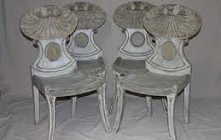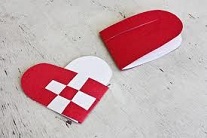When it comes to wooden shoes, the French may have their sabots and Dutch may have their klompen. However, perhaps one of the best kept secretsin Europe is painted Swedish wooden clogs…
Although the Swedish shoes, like the Dutch and the French ones, may have had their genesis in addressing the practical needs of life, painted Swedish clogs are attractive and fashionable as well.
Although the Dutch style clogs are traditionally made entirely of wood and don’t incorporate leather or other supple materials like Swedish clogs do, it may be that the tradition of hand-painting clogs originated in the Netherlands. In former times Dutch peasants left their farm shoes at home and wore wooden clogs painted with bright patterns to festive or formal occasions.
Tradition tells us that it was a Swede named August Johanssen who revolutionized the old wooden shoe in 1907. His innovative manufacturing techniques involved orthopaedically carving alder wood and lasting the leather uppers in his small factory located in the town of Troentorp, just outside of Båstad in Southern Sweden.
Since the 1970s Swedish clogs have been considered fashionable attire for both men and women. The sockless 70s began the trend of wearing the half sandal clog with a wooden foundation without socks. Many a fashionable 70s gentleman complemented his turtleneck or Nehru jacket with a pair of clogs on otherwise bare feet.
Heel height on painted Swedish clogs can vary from near flat to extremely high. The decorative possibilities afforded by quality leather or polyurethane and wood make for a very interesting “canvas” for shoe designers to exercise their most creative notions.
Nowadays the best painted Swedish wooden clogs are handcrafted using only the very best materials, with particular attention paid to details. The result is footwear that offers both a variety of styles while guaranteeing comfort to the wearer.
Painting clogs in folk art like patterns and designs is a longstanding tradition in some parts of Sweden. One such traditional folk pattern is called kurbits and originates from from Dalarna, a region in central Sweden renowned as well for its painted furniture and horses.
This decorative tradition may have had its inception in the 1700s. In those days biblical motifs were common in peasant’s homes. Painting all sorts of household goods and implements made of wood became increasingly popular over time. Painting of wooden clogs dates from the middle of the 20th century at least in Dalarna.
Nowadays clogs created by Swedish designer Åsa Westlund, who hails from Dalarna, feature wooden soles, leather uppers, and are hand-painted in the traditional Swedish kurbits style as well.
Increasingly Swedish-inspired patterns are finding their way onto clogs that claim to be genuine painted Swedish wooden clogs that are actually created in far flung shops and factories in North America, Europe and Asia.





